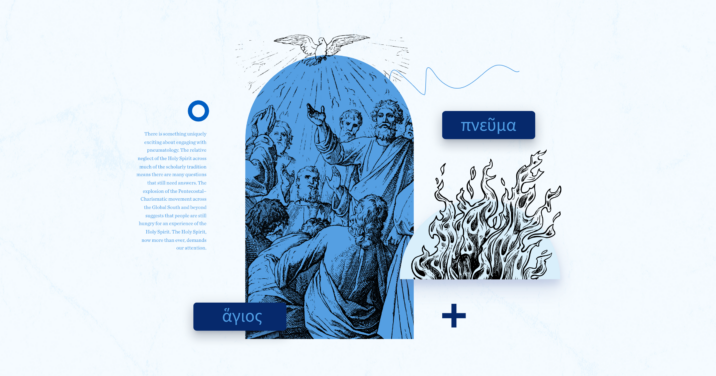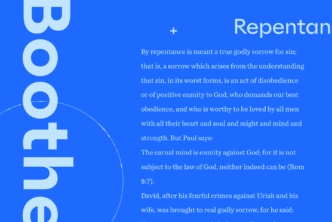This article will provide a brief introduction to pneumatology by answering a few key questions:
- What do the biblical terms ruach and pneuma have to do with the Holy Spirit?
- How did early Christians go about the task of reflecting on the person and work of the Holy Spirit?
- What is the significance of the study of pneumatology today?
Lexical issues regarding the Holy Spirit
The semantic range of the Hebrew word ruach is quite broad throughout its nearly four hundred occurrences across the Old Testament. It can, at times, refer to “wind” (e.g., Num 11:31), “breath” (e.g., Gen 6:17), or “spirit” (e.g., Gen 26:35). Additionally, there are times in which this word appears to clearly point to something more metaphysical and even personal, as in references to the “Spirit of God,” “Spirit of the Lord,” or “Holy Spirit.”1
The significance of this semantic breadth for pneumatology is this: it can often be quite tricky to distinguish between when ruach is being used to refer to some natural force versus to something divine. Take, for example, Genesis 1:2, which notes, “And the ruach of God was hovering over the face of the waters.” Some translations, such as the ESV, translate ruach as “Spirit,” while others, such as the NRSV, translate it as “wind.” Both are acceptable translations of ruach, and so appeal must be made to broader canonical or theological frameworks.2
The New Testament, however, brings the Holy Spirit into clearer focus. The Greek word most closely corresponding to the Hebrew ruach is pneuma (hence, “pneumatology”), which likewise has a broad semantic range.3 The New Testament is particularly interested in describing the experience of the Spirit in the life of a Christ-follower. As one scholar has summarized, in the New Testament we see the Spirit bringing a vivid sense of God’s presence, illuminating the mind regarding the things of God, and empowering a life of faith and virtue.4
The New Testament also clarifies that the Holy Spirit is, in fact, a person, and not something akin to the Force from Star Wars. This is most clearly demonstrated in Jesus’ “farewell discourse” in John 13:31–16:33, which introduces still another term for the Holy Spirit. Here Jesus portrays the Holy Spirit as the “Paraclete” (Greek paraklētos). Lexically, we should think of this term less as a cozy-blanket “Comforter” and more as an “Advocate” in a legal sense.5
The forensic purpose of the Paraclete, who is after all the “Spirit of truth” (John 14:17), is to testify on Jesus’ behalf after Jesus’ ascension, and the set of verbs ascribed to the Paraclete in this passage would seem to demand a personal agent as their subject. This image would, indeed, play an outsized role in later thinking about the distinct divine personhood of the Holy Spirit.6
Ruach and pneuma are, therefore, sometimes tricky biblical words. In some instances it is difficult to pin down whether they are referring to the personal Holy Spirit or to some impersonal force like wind or breath. Careful attention to the text of Scripture would indeed be the first and primary source for pneumatological reflection as the early church developed this particular doctrine.
Sources of pneumatological reflection
Early Christian reflection on the person and work of the Holy Spirit was primarily drawn from three historic sources for pneumatological reflection:
1. Biblical interpretation
The study of the Holy Spirit begins, of course, with the Bible. As mentioned above, New Testament passages such as Jesus’ farewell discourse in John’s Gospel have been crucial for pneumatological reflection. The earliest writers to focus exclusively on the Holy Spirit, including Athanasius of Alexandria, Didymus the Blind, and Basil the Great, help us surface some of the earliest debates regarding the Bible and the Holy Spirit.
To take just one example, we can return to the issue of the semantic range of ruach. We see in Athanasius’ writings that a major objection of those who denied the divinity of the Spirit was Amos 4:13, which speaks of God “creating” ruach. In response, Athanasius provides a survey of the use of ruach in the Old Testament, concluding that when ruach is used without qualification, it does not refer to the Holy Spirit proper (Serap. 1.3–10 [trans. DelCogliano et al.]).
Indeed, the early Christians often placed great weight on the Old Testament’s witness to the Holy Spirit. As I have demonstrated elsewhere, the early church found the Trinity in the Old Testament. In particular, person-centered reading strategies enabled church fathers to interpret dialogues (as, for instance, in the Psalms) as conversations between divine persons. This contributed to the development not only of Christology, but also of pneumatology.
Tertullian (d. 220), for instance, believed that in some Old Testament dialogues, “the distinction of the Trinity is clearly set forth. For there is the Spirit himself who speaks, the Father to whom he speaks, and the Son of whom he speaks” (Prax. 11.9 [my translation]). One of these passages, Tertullian claims, is Psalm 110:1: “The Lord said to my Lord: Sit at my right hand, until I make your enemies a footstool for your feet.” As Tertullian interprets this verse, we have here an instance of “the Spirit speaking from a third person concerning the Father and the Son” (Prax. 11.7).
The logic is as follows: if we understand the spoken dialogue of Psalm 110:1b–c as the words of the Father to the Son (as was the consensus of the early church; cp. Mark 12:35–37; Heb 1:13), then who could possibly be in a position to report this heavenly dialogue (Ps 110:1a)? Only the Holy Spirit, who “searches everything, even the depths of God” (1 Cor 2:10) could be in a position to do so. Such appeals to the Spirit as a “person” participating in divine dialogues such as this one played an important role in the realization that the Spirit is a distinct divine person.7
As through all of church history, every heresy claims to be “biblical.” On what basis, then, can we adjudicate the claims of various viewpoints to represent the more biblical understanding of the Holy Spirit? For the early church, beyond the usual linguistic and exegetical arguments, the answer came from a perhaps surprising direction: the liturgy of the church.
2. Liturgical tradition
Around the year 375, in the latter stages of the debate over the full deity of the Holy Spirit, Basil of Caesarea penned his treatise On the Holy Spirit. This work responded to the so-called Pneumatomachians, who denied the divinity of the Spirit but affirmed the deity of the Son. As with the other fourth-century theological controversies that divided the church, each side appealed to Scripture to support its position.
With great (perhaps even exhaustive) treatment of the nature of Greek prepositions, Basil certainly made biblical arguments for the deity of the Spirit based on the text of Scripture. But Basil went further. For Basil, the worship (or liturgy) of the church plays a decisive role in scriptural interpretation.
Basil’s key insight in this regard is drawn from the doxology sometimes called the Gloria Patri: “Glory be to the Father, and to the Son, and to the Holy Spirit.” The liturgy, therefore, explicitly ascribes glory to the Holy Spirit. Basil’s critics complained that this phrase could nowhere be explicitly found in Scripture. Basil, however, points out that this doxology was handed down “from the fathers” as “the authentic custom of churches that have not turned away” (Spir. 27.67 [trans. Hildebrand]).
Of course, Basil still provides biblical warrant for this extra-scriptural tradition. Basil points to Matthew 28:19, in which Christ commands his church to baptize “in the name of the Father and of the Son and of the Holy Spirit.” Thus, when the Spirit is linked with the Father and the Son in the Gloria Patri, this is merely building off of precedent established by Christ himself. As Basil explains, “If the Lord had not joined the Spirit to himself and to the Father in baptism, then let them not blame us for the joining, for we neither think nor say anything different” (Spir. 10.24 [trans. Hildebrand]).
In other words, the Gloria Patri, like the doctrine of the Trinity, is not explicitly found in Scripture. It is, in a real sense, a non-scriptural tradition handed down by the church. It is, however, also deeply and authentically biblical, expressing the true sense of Scripture as interpreted in light of Christ. As Basil summarizes, “If from the tradition of baptism we make a confession similar to baptism (according to the logic of piety, as we baptize, so we ought to believe), then let them grant to us from this same logic to give glory in a way similar to our confession” (Spir. 27.67 [trans. Hildebrand]).
If our modern pneumatologies are to be true to how the early church developed the doctrine of the Holy Spirit, we too would be wise to follow Basil’s lead. Lex orandi, lex credendi: “The rule of prayer is the rule of belief.” Attention to the Spirit’s role in the liturgy and worship of the church, provided such things have sufficient biblical warrant, can contribute to our understanding of the person and work of the Spirit.
3. Personal or corporate experience
Finally, for the early Christians, the personal experience of the Holy Spirit was central to their theological reflection on the person and work of the Spirit.
This is evident in the New Testament itself, with the Holy Spirit’s coming at Pentecost (Acts 2:1–27) birthing the church. Paul’s churches emphasized the Holy Spirit’s presence in worship—perhaps to an unhealthy extreme, as Paul himself reflects (1 Cor 12). The Spirit was the source of ecstatic experiences (Acts 2:2–4) and a variety of charismatic gifts (1 Cor 12:8–10). No wonder, then, that N. T. Wright talks about early Christian theology of the Spirit being cast in “the language of experience.”8
In our hyper-individualized society, it can be tempting to think solely in terms of “my personal” experience of the Spirit. The testimony of Scripture, however, is that the Spirit is given for the building up of the body of Christ (1 Cor 12:7, 12–31). While the Spirit is indeed living and active in each of us who are united to Christ (Rom 8:9), the corporate experience of the Spirit provides an important check on charismatic excesses.
Contrary to the views of some cessationists, the witness of the early church fathers is clear that such charismatic experiences continued beyond the apostolic age. To take just one example, Justin Martyr (d. 165) shows the centrality of the Spirit even in a time of increased liturgical and ecclesiological consolidation. As Justin writes, “Now, if you look around, you can see among us Christians both male and female endowed with charisms from the Spirit of God” (Dial. 88.1 [trans. Falls]; cp. 87.5–6). As Justin specifies earlier, “Among us Christians the charisms of prophecy exist down to the present day” (Dial. 82.1).
Reading the New Testament and the early church fathers, it is clear that early reflection on the Holy Spirit was motivated by a passionate, personal experience of the Spirit. Paul says that “no one knows the things of God except the Spirit of God,” given to us “that we might know the things that have been freely given to us by God” (1 Cor 2:11–12).
If we recognize that all truly Christian theological work must be done in the Spirit, how much more should our investigations into the Spirit require a vital connection with the Spirit? And, like the church fathers, we need to look for the Spirit’s work today as we reflect on the doctrine of the Holy Spirit. This does not, of course, mean that we need to accept every claim that something is “of the Spirit,” but an openness to the Spirit as living and active, and not simply a subject of historical study, is required for authentic pneumatology.
Summary
Christians will no doubt continue to disagree on how exactly to assess and weigh each of these categories. But this threefold approach helps us to see pneumatology as not simply an intellectual exercise; it is, rather, an inquiry into a person who shapes Christ’s church and the lives of the individuals who follow his leading into all truth. A truly Christian approach to pneumatology will proceed from the truth that the subject of our study is also the one who illuminates our minds.
From these three sources, early Christian reflection on the Holy Spirit culminated in the development of the orthodox doctrine of the Holy Spirit: that he is a distinct divine person, an equal member of the Trinity with the Father and the Son. All subsequent Christian inquiry into pneumatology must begin from this point.
Why is pneumatology important?
There is something uniquely exciting about engaging with pneumatology. The relative neglect of the Holy Spirit across much of the scholarly tradition means there are many questions that still need answers. The explosion of the Pentecostal–Charismatic movement across the Global South and beyond suggests that people are still hungry for an experience of the Holy Spirit. The Holy Spirit, now more than ever, demands our attention.
Moreover, a recovery of the doctrine of the person and work of the Holy Spirit is essential if we are to keep the Spirit from being the “forgotten” member of the Trinity. We must take seriously Jesus’ surprising words in John 16:7: “Nevertheless, I tell you the truth: it is to your advantage that I go away, for if I do not go away, the Helper will not come to you. But if I go, I will send him to you.” Pneumatology is important because Jesus says it is important.
Our gospel, ultimately, must be Trinitarian in shape: the Father sends the Son, our saving King, who in turn sends the Holy Spirit to indwell and empower his people.9 We cannot understand Good Friday or Easter apart from the Ascension or Pentecost. Our increased appreciation for the Holy Spirit’s role in our salvation allows us to catch still further glimpses of the wonders of God’s amazing grace. Rightly understood, the study of pneumatology should lead us to worship.
Digging deeper: recommended resources for further study
While this article aims to be an introduction to some of the factors that have historically driven the study of the person and work of the Holy Spirit, it merely scratches the surface of the broader field of pneumatology.
Where should you turn next if you’re interested in learning more?
1. Start by searching the Scriptures for yourself!
Read (and re-read and re-read) John 14–16, where we get some of the most important biblical material regarding the person and work of the Spirit. Paul’s letters also give many important references to the Spirit that you could try categorizing and analyzing.
2. Check out key patristic sources
I’d start with Basil the Great’s classic work, On the Holy Spirit, which I’ve referenced a few times above. It’s a good introduction to patristic theology and biblical interpretation in general, but also sets out some key fourth-century debates that helped crystallize orthodox teaching on the Spirit.
3. Check out recent scholarship
Among more recent secondary sources, a systematic evangelical take on pneumatology focusing on biblical texts is Graham Cole’s He Who Gives Life (Crossway, 2007). For more of a sweeping historical narrative, Veli-Matti Kärkkäainen’s Pneumatology (2nd ed.; Baker Academic, 2018) is a useful introduction. A nice overview of both biblical and historical themes can be found in Myk Habets’s The Progressive Mystery (Lexham, 2019). And my How the Spirit Became God (Cascade, 2020) zooms in on key issues in the first four Christian centuries. Any of these would be good starting points for further reflection and investigation.
How the Spirit Became God: The Mosaic of Early Christian Pneumatology
Regular price: $17.99
The Progressive Mystery: Tracing the Elusive Spirit in Scripture and Tradition
Regular price: $15.99

He Who Gives Life: The Doctrine of the Holy Spirit (Foundations of Evangelical Theology)
Regular price: $23.99
- On the semantic range of ruach in the Old Testament, see Myk Habets, The Progressive Mystery: Tracing the Elusive Spirit in Scripture and Tradition (Bellingham, WA: Lexham Press, 2019), 9–21.
- See further Graham A. Cole, He Who Gives Life: The Doctrine of the Holy Spirit (Wheaton, IL: Crossway, 2007), 96–100.
- On the relationship of ruach to pneuma, see further Habets, Progressive Mystery, 47–53.
- See further John Eifion Morgan-Wynne, Holy Spirit and Religious Experience in Christian Literature ca. AD 90–200 (Milton Keynes, UK: Paternoster, 2006), 17–18.
- See further Kyle R. Hughes, How the Spirit Became God: The Mosaic of Early Christian Pneumatology (Eugene, OR: Cascade, 2020), 19–25.
- See further Hughes, How the Spirit Became God, 25–27.
- See further Hughes, How the Spirit Became God, 54–76.
- N. T. Wright, The New Testament and the People of God (Minneapolis, MN: Fortress Press, 1992), 446.
- See further Matthew W. Bates, Why the Gospel? (Grand Rapids, IL: Eerdmans, 2023), 73–74.









